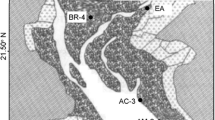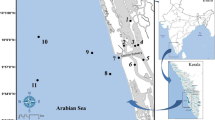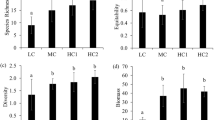Abstract
The positive influence of mangrove vegetation on macrobenthic communities has been widely investigated, but studies mainly focused on epibenthic assemblages. Given the contrasting characteristics between epifauna and infauna, we expected that mangrove vegetation would not exert the same positive effect on infaunal assemblages. To test this hypothesis, we investigated polychaete assemblages in mangrove stands in a tidal flat in Southeast Brazil. Specifically, we focused on (a) whether polychaete assemblages (i.e., density, richness, community, and feeding guild composition) are different inside and outside mangrove stands, and (b) if changes are related to root biomass. Our results showed that mangrove areas have lower polychaete density than that of adjacent sandflats, and polychaete density is negatively related to root biomass. Species richness was not affected by the presence of vegetation, but the number of exclusive species was higher inside the mangrove. Changes in composition of polychaete assemblages were mainly attributable to reductions in species density rather than species replacement. Trophic structure was not influenced by mangrove vegetation, as subsurface-feeders dominated inside and outside mangrove zones. Our results contrast with the richness enhancement found for epibenthic fauna inside mangroves, and highlight that mangrove vegetation does not exert the same influence on epibenthic as that on infaunal assemblages.



Similar content being viewed by others
References
Alongi, D. M., 2008. Mangrove forests: resilience, protection from tsunamis, and responses to global climate change. Estuarine, Coastal and Shelf Science 76: 1–13.
Alongi, D. M. & P. Christoffersen, 1992. Benthic infauna and organism-sediment relations in a shallow, tropical coastal area: influence of outwelled mangrove detritus and physical disturbance. Marine Ecology Progress Series 81: 229–245.
Amaral, A. C. Z., M. R. Denadai, A. Turra & A. E. Rizzo, 2003. Intertidal macrofauna in Brazilian subtropical tide-dominated sandy beaches. Journal of Coastal Research SI 35: 446–455.
Amaral, A. C. Z., A. E. Migotto, A. Turra & Y. Schaeffer-Novelli, 2010. Araçá: biodiversidade, impactos e ameaças. Biota Neotropica 10: 219–264.
Bassoullet, P., P. Le Hir, D. Gouleau & S. Robert, 2000. Sediment transport over an intertidal mud flat: field investigations and estimation of fluxes within the “Baie Marenngres-Olerin (France). Continental Shelf Research 20: 1635–1653.
Bates, D. M. 2010. lme4: Mixed-Effects Modeling with R. http://lme4r-forger-project.org/book.
Bates, D., M. Maechler, B. Bolker & S. Walker, 2015. Fitting linear mixed-effects model using lme4. Journal of Statistical Software 67: 1–48.
Bolker, B. M., M. E. Brooks, C. J. Clark, S. W. Geange, J. R. Poulsen, M. H. H. Stevens & J. S. White, 2009. Generalized linear mixed-models: a practical guide for ecology and evolution. Trends in Ecology and Evolution 24: 127–135.
Bosire, J. O., F. Dahdoud-Guebas, J. G. Kairo, S. Cannicci & N. Koedam, 2004. Spatial variations in macrobenthic fauna recolonization in a tropical bay. Biodiversity and Conservation 13: 1059–1074.
Bouillon, S., N. Koedan, A. V. Ramam & F. Dehairs, 2002. Primary producers sustaining macro-invertebrate communities in intertidal mangrove forests. Oecologia 130: 441–448.
Camargo, M. G., 2006. Sysgran: um sistema de código aberto para análises granulométricas do sedimento. Revista Brasileira de Geociências 36: 371–378.
Chapman, M. G. & T. J. Tolhurst, 2004. The relationship between invertebrate assemblages and bio-dependent properties of sediment in urbanized temperate mangrove forests. Journal of Experimental Marine Biology and Ecology 304: 51–73.
Checon, H. H., E. V. Pardo & A. C. Z. Amaral, 2017. Breadth and composition of polychaete diets and the importance of diatoms to species and trophic guilds. Helgoland Marine Research 70: 19.
Dittmann, S. R., 2001. Abundance and distribution of small infauna in mangroves of Missionary Bay, North Queensland, Australia. Revista de Biología Tropical 49: 535–544.
Edgar, G. J., 1990. The influence of plant structure on the species richness, biomass and secondary production of macrofaunal assemblages associated with Western Australian seagrass beds. Journal of Experimental Marine Biology and Ecology 137: 215–240.
Ewel, K. C., R. R. Twilley & J. E. Ong, 1998. Different kinds of mangrove forests provide different goods and services. Global Ecology and Biogeography 7: 83–94.
Fauchald, K. & P. A. Jumars, 1979. The diet of worms: a study of polychaete feeding guilds. Oceanography Marine Biology Annual Review 17: 193–284.
Folk, R. L. & W. C. Ward, 1957. Brazos River Bar: a study in the significance of grain-size parameters. Journal of Sedimentary Petrology 27: 3–26.
Fournier, D. A., H. J. Skaug, J. Ancheta, J. Ianelli, A. Magnusson, A. Nielsen & J. Sibert, 2012. AD Model Builder: using automatic differentiation for statistical inference of highly parametrized complex non-linear models. Optimization Methods and Software 27: 233–249.
Frith, D. W., R. Tantanasiriwong & O. Bhatia, 1976. Zonation and abundance of macrofauna on a mangrove shore, Phuket Island. Phuket Marine Biological Centre Research Bulletin 10: 1–37.
Gaudette, H. E., W. R. Flight, L. Toner & D. W. Folger, 1976. An inexpensive tritation method for the determination of organic carbon in recent sediments. Journal of Sediment Petrology 44: 249–253.
Glaser, M., 2003. Interrelations between mangrove ecosystem, local economy and social sustainability in Caeté Estuary, North Brazil. Wetlands Ecology and Management 11: 265–272.
Jumars, P. A., K. M. Dorgan & S. M. Lindsay, 2015. Diet of worms emended: an update of polychaete feeding guilds. Annual Review of Marine Science 7: 497–520.
Kathiresan, K. & B. L. Bingham, 2001. Biology of mangroves and mangrove ecosystems. Advances in Marine Biology 40: 81–251.
Kon, K., H. Kurokura & P. Tongnunui, 2010. Effects of the physical structure of mangrove vegetation on a benthic faunal community. Journal of Experimental Marine Biology and Ecology 383: 171–180.
Krauss, K. W., J. A. Allen & D. R. Cahon, 2003. Differential rates of vertical accretion and elevation change among aerial root types in Micronesian mangrove forests. Estuarine, Coastal and Shelf Science 56: 251–259.
Lana, P. C., E. C. G. Couto & M. V. O. Almeida, 1997. Polychaete distribution and abundance in intertidal flats of Paranaguá Bay (SE Brazil). Bulletin of Marine Science 60: 433–442.
Le Hir, P., W. Roberts, O. Cazaillet, M. Christie, P. Bassoullet & C. Bacher, 2000. Characterization of intertidal flat hydrodynamics. Continental Shelf Research 20: 1433–1459.
Lee, S. Y., 2008. Mangrove macrobenthos: assemblages, services and linkages. Journal of Sea Research 59: 16–29.
Mattos, G., R. S. Coutinho & A. S. Santos, 2013. Environmental effects on the structure of polychaete feeding guilds on the beaches of Sepetiba Bay, south-eastern Brazil. Journal of the Marine Biological Association of the United Kingdom 93: 973–980.
Metcalfe, K. N. & C. J. Glasby, 2008. Diversity of Polychaeta (Annelida) and other worm taxa in mangrove habitats of Darwin Harbour, northern Australia. Journal of Sea Research 59: 70–82.
Nagelkerken, I., S. J. M. Blaber, S. Bouillon, P. Green, M. Haywood, L. G. Kirton, J. O. Meynecke, J. Pawlik, H. M. Penrose, A. Sasekumar & P. J. Somerfield, 2008. The habitat function of mangroves for terrestrial and marine fauna: a review. Aquatic Botany 89: 155–185.
Netto, S. A. & F. Gallucci, 2003. Meiofauna and macrofauna communities in a mangrove from the Island of Santa Catarina, South Brazil. Hydrobiologia 505: 159–170.
Netto, S. A. & P. C. Lana, 1997. Intertidal zonation of benthic macrofauna in a subtropical salt marsh and nearby unvegetated flat (SE, Brazil). Hydrobiologia 353: 171–180.
Nobbs, N., 2003. Effects of vegetation differ among three species of fiddler crabs (Uca spp.). Journal of Experimental Marine Biology and Ecology 284: 41–50.
O’Hara, R. B. & D. J. Kotze, 2010. Do not log-transform data count. Methods in Ecology and Evolution 1: 118–122.
Pagliosa, P. R., 2005. Another diet of worms: the applicability of polychaete feeding guilds as a useful conceptual framework and biological variable. Marine Ecology 26: 246–254.
Pagliosa, P. R. & P. C. Lana, 2005. Impact of plant cover removal on macrobenthic community structure of a subtropical salt marsh. Bulletin of Marine Science 77: 1–18.
Pearson, T. H. & R. Rosenberg, 1978. Macrobenthic succession in relation to organic enrichment and pollution of the marine environment. Oceanography and Marine Biology Annual Review 16: 229–311.
Pillay, D., G. M. Branch & A. T. Forbes, 2007. Experimental evidence of the effects of the thalassinidean shrimp Callianassa kraussi on macrobenthic communities. Marine Biology 152: 611–618.
Pinedo, S., R. Sardá & D. Martin, 1997. Comparative study of the trophic structure of soft-bottom assemblages in the Bay of Blanes (Western Mediterranean Sea). Bulletin of Marine Science 60: 529–542.
R Core Development Team, 2016. R: A language and environment for statistical computing. R Foundation for statistical computing, Vienna, Austria. http://www.R-project.org/.
Rhoads, D. C. & D. K. Young, 1970. The influence of deposit-feeding organisms on sediment stability and community trophic structure. Journal of Marine Research 28: 150–178.
Richoux, N. B. & P. W. Froneman, 2008. Trophic ecology of dominant zooplankton and macrofauna in a temperate, oligotrophic South African estuary: a fatty acid approach. Marine Ecology and Progress Series 357: 121–137.
Sardà, R., 1991. Polychaete communities related to plant covering in the mediolittoral and infralittoral zones of the Balearic Islands (Western Mediterranean). Marine Ecology 12: 341–360.
Schaeffer-Novelli, Y., G. Cintrón-Molero & R. R. A. T. M. Camargo, 1990. Variability of mangrove ecosystems along the Brazilian coast. Estuaries 13: 204–2018.
Sheridan, P., 1997. Benthos of adjacent mangrove, seagrass and non-vegetated habitats in Rookery Bay, Florida, USA. Estuarine and Coastal Shelf Science 44: 455–469.
Snelgrove, P. V. R. & C. A. Butman, 1994. Animal sediment relationships revisited- cause versus effect. Oceanography Marine Biology 32: 111–177.
Suguio, K., 1973. Introdução a sedimentologia. EDUSP, São Paulo.
Summerson, H. C. & C. H. Peterson, 1984. Role of predation in organizing benthic communities of a temperate zone seagrass beds. Marine Ecology and Progress Series 15: 63–77.
Wang, Y., U. Naumann, S. Wright & D. Warton, 2012. mvabund – an R package for model-based analysis of multivariate abundance data. Methods in Ecology and Evolution 3: 471–474.
Wang, Y., U. Naumann, S. Wright & D. Warton, 2014. mvabund: statistical methods for analyzing multivariate abundance data. http://CRAN.R-project.org/package=mvabund.
Warton, D. I., S. T. Wright & Y. Wang, 2012. Distance-based multivariate analysis confound location and dispersion effects. Methods in Ecology and Evolution 3: 89–101.
Weston, D. P., 1990. Quantitative examination of macrobenthic community changes along an organic enrichment gradient. Marine Ecology Progress Series 61: 233–244.
Whitcraft, C. R. & L. A. Levin, 2007. Regulation of benthic algae and animal communities by salt marsh plants: impacts of shading. Ecology 88: 904–917.
Young, B. M. & L. E. Harvey, 1996. A spatial analysis of the relationship between mangrove (Avicennia marina var australasica) physiognomy and sediment accretion in the Haruaki Plains, New Zealand. Estuarine, Coastal and Shelf Science 42: 231–246.
Acknowledgements
Financial support to this study was provided by the BIOTA/FAPESP—ARAÇÁ project (Proc. No. 2011/50317-5); CAPES Foundation PhD’s scholarship to CF Silva, GN Corte (Proc. 14796/13-9), and HH Checon; FAPESP (Grants No: 2011/10130-3 and 2016/10810-8 to GN Corte); and CNPQ (Grant No: 306534/2015 to ACZ Amaral). The authors are very grateful to AS Godoy for helping with handling of databases for analysis, and to DG Filho, RF Daolio, N Padovanni, RK Murayama, AS Godoy, R Luchetti, and R Alitto for helping to collect and sieve all the samples. The authors are also grateful for two anonymous reviewers for their helpful inputs, and to M.Sc Yasmina Shah Esmaeili for language review.
Author information
Authors and Affiliations
Corresponding author
Additional information
Handling editor: I.A. Nagelkerken
Rights and permissions
About this article
Cite this article
Checon, H.H., Corte, G.N., Silva, C.F. et al. Mangrove vegetation decreases density but does not affect species richness and trophic structure of intertidal polychaete assemblages. Hydrobiologia 795, 169–179 (2017). https://doi.org/10.1007/s10750-017-3128-0
Received:
Revised:
Accepted:
Published:
Issue Date:
DOI: https://doi.org/10.1007/s10750-017-3128-0




